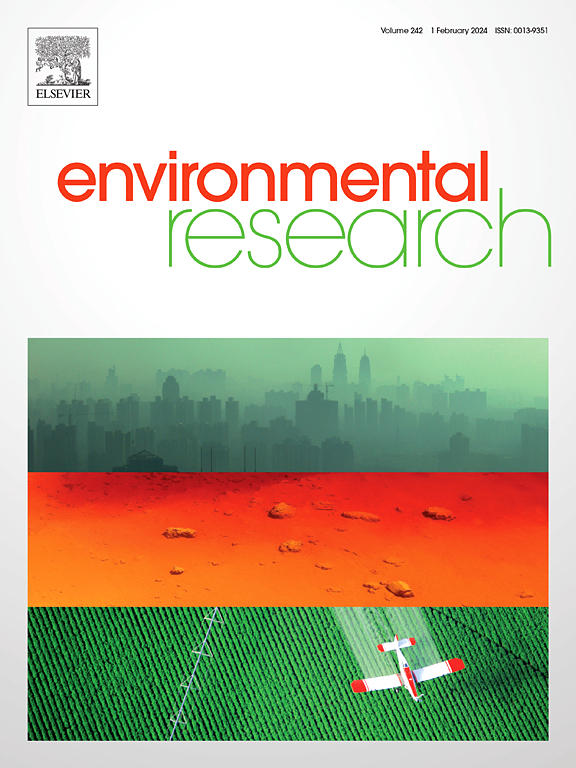高吸附废水中铅(II)的氧化锰改性生物炭的制备及其吸附机理
IF 7.7
2区 环境科学与生态学
Q1 ENVIRONMENTAL SCIENCES
引用次数: 0
摘要
废水中二价铅(Pb(II))超标的发生对人类健康和生态安全构成了显著威胁。本研究采用正交试验的方法制备了共沉淀改性生物炭(C-BC)和高锰酸钾(KMnO4)浸渍热解改性生物炭(I-BC)去除废水中铅(II)。3种改性生物炭(bc) (mn - bc)对400 mg/L Pb(II)的去除率分别为87.2%、88.0%和91.2%,分别为C-BC400、I-BC400和I-BC700。透射电镜(TEM)和扫描电镜(SEM) -能散x射线能谱(EDS)分析结果表明,Mn元素只分布在C-BC400颗粒的外表面,而出现在I-BC400和I-BC700颗粒的外表面,并稳定地嵌入其中。与原始(bc)相比,C-BC400、I-BC400和I-BC700对Pb(II)的吸附率分别提高了3.75、2.09和5.70倍。C- bc400、I-BC400和I-BC700对Pb(II)的吸附量分别为182.28、133.16和69.25 mg/g,显著高于400°C (45.43 mg/g)和700°C (40.71 mg/g)条件下生产的原始bc。mn - bc对Pb(II)的优异吸附能力取决于多种吸附机制,包括络合、静电吸引、表面吸附和离子交换。结果表明,Mn-BCs在Pb(II)污染废水的修复中具有很高的应用潜力。本文章由计算机程序翻译,如有差异,请以英文原文为准。

Mn oxide-modified biochars with high adsorption capacity for Pb(II) in wastewater: Preparation and adsorption mechanisms
The occurrence of excessive levels of bivalent plumbum (Pb(II)) in wastewater poses a notable threat to both human health and ecological safety. In this study, orthogonal experiments were conducted to prepare coprecipitation-modified biochar (C-BC) and impregnation pyrolysis-modified biochar (I-BC) via potassium permanganate (KMnO4) for removing Pb(II) from wastewater. Three types of modified biochars (BCs) (Mn-BCs) namely, C-BC400, I-BC400, and I-BC700, were selected as high-efficiency adsorbents on the basis of their high removal rates (87.2%, 88.0%, and 91.2%, respectively) for 400 mg/L Pb(II) solutions. The transmission electron microscopy (TEM) and scanning electron microscopy (SEM)‒energy-dispersive X-ray spectroscopy (EDS) analysis results indicated that Mn elements were distributed only on the outer surfaces of the C-BC400 particles but occurred on the outer surface and were stably embedded in the I-BC400 and I-BC700 particles. Compared with those of the pristine (BCs), the Pb(II) adsorption rates of C-BC400, I-BC400, and I-BC700 increased by factors of 3.75, 2.09, and 5.70, respectively. The Pb(II) adsorption capacities of C-BC400, I-BC400, and I-BC700 (182.28, 133.16, and 69.25 mg/g, respectively) were significantly greater than those of the pristine BCs produced at 400 °C (45.43 mg/g) and 700 °C (40.71 mg/g). The excellent adsorption ability of Mn-BCs for Pb(II) depends on various adsorption mechanisms, including complexation, electrostatic attraction, surface adsorption, and ion exchange. These results suggest that Mn-BCs exhibit high application potential in the remediation of Pb(II)-contaminated wastewater.
求助全文
通过发布文献求助,成功后即可免费获取论文全文。
去求助
来源期刊

Environmental Research
环境科学-公共卫生、环境卫生与职业卫生
CiteScore
12.60
自引率
8.40%
发文量
2480
审稿时长
4.7 months
期刊介绍:
The Environmental Research journal presents a broad range of interdisciplinary research, focused on addressing worldwide environmental concerns and featuring innovative findings. Our publication strives to explore relevant anthropogenic issues across various environmental sectors, showcasing practical applications in real-life settings.
 求助内容:
求助内容: 应助结果提醒方式:
应助结果提醒方式:


